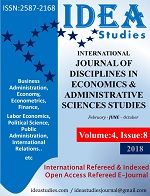Author :
Abstract
Son yıllarda birçok ülkede gelir eşitsizliğindeki artışlar oldukça dikkat çekmektedir. Gelir eşitsizliğindeki bu fark edilen artışın hızlı teknolojik gelişmelerle aynı zamana denk gelmesi, teknolojik yayılmanın gelir eşitsizliğini artırdığına dair iddiaların ortaya çıkmasına neden olmaktadır. Bu bağlamda, çalışmada 1997–2010 dönemi için, Türkiye’nin de dahil olduğu 28 OECD ülkesinde teknolojik yayılmanın gelir eşitsizliği üzerine etkisini panel veri analizi ile araştırmak amaçlanmaktadır. Gelir eşitsizliği, en uygun ölçüt olan Theil endeksi ile hesaplanmıştır. Teknolojik yayılma ise kişi başına düşen patent sayısı ve yüksek teknoloji gerektiren ürünlerin toplam ithalatı olmak üzere iki farklı şekilde ölçülerek modellenmiştir. Analiz sonucunda, teknolojik yayılmanın gelir eşitsizliğini arttırdığı iddiası doğrulanmaktadır. Ancak, daha kaliteli eğitimin teknolojik yayılmanın gelir eşitsizliği üzerindeki olumsuz etkiyi azalttığı bulgusu elde edilmiştir.
Keywords
Abstract
In recent years the acceleration of the increase in income inequality in many countries is quite noteworthy. Because this noticeable increase in income inequality coincided with rapid technological progress, a claim "technological diffusion increases the income inequality" has emerged as one of the hypothesis. In this context, this study aimed to investigate the effect of technological diffusion on income inequality with panel data analysis for the period of 1997 to 2010, covering 28 OECD countries including Turkey. Income inequality is calculated by Theil index as the most appropriate measurement method. Technological diffusion is measured and modeled in two different ways: per capita patents and total imports of products with high technological intensity. As a result of this study, "technological diffusion increases income inequality" hypothesis is confirmed. However, the study also found that higher quality in education reduces the negative impact of technological diffusion on income inequality.
Keywords
- Acemoglu, D., (2002). “Technical change, inequality, and the labor market”, Journal of Economic
- Acemoglu, D., (2002). “Technical change, inequality, and the labor market”, Journal of Economic Literature Vol. XL: 7-72.
- Asteriou, D.; Dimelis, S. ve Moudatsou, A. (2014). “Globalization and income inequality: A panel data econometric approach for the EU27 countries”. Economic modelling, 36, 592-599.
- Autor, D.; Katz, L. ve Krueger, A., (1998). “Computing inequality: have computers changed the labor market?”, Quarterly Journal of Economics, 113(4): 1169-1214.
- Baltagi, B. (2008), Econometric analysis of panel data (4th ed.). John Wiley&Sons Ltd, UK.
- Berman, E.; Bound, J. ve Machin, S., (1998). “Implications of skill-biased technological change: International evidence”, Quarterly Journal of Economics 113(4): 1245-79.
- Conceicao, P. ve Galbraith, J. (2000). “Technology adoption and inequality: empirical evidencefrom a selection of OECD countries”, 33rd Hawaii International Conference on System Sciences, vol. 7.
- Çalışkan, Ş. (2010). “Türkiye’de gelir eşitsizliği ve yoksulluk. Sosyal Siyaset Konferansları”, 59(2): 89-132.
- Çelik, N. (2008). “Beceri yanlı teknolojik değişme yaklaşımı ve gelişmiş ülkelerde işgücü talebi”,Bilim, Eğitim ve Düşünce Dergisi, Cilt 8, Sayı 3. http://www.universite- toplum.org/text.php3?id=372.
- Davidson, R. ve MacKinnon, J. (2003). Econometric theory and methods. UK: Oxford UniversityPress.
- Dabrowski, M. (2017). “Is it a trade-off between global and national income inequality?”. Paper forthe 14th EUROFRAME Conference on Economic Policy Issues in the European Union – Growth and Inequality: Challenges for EU Economies, Berlin, June 9, 2017).
- Eaton, J. ve Kortum, S. (1995). “Trade in ideas. Patenting and productivity in the OECD”, NBER Working Paper Series. No. 5049.
- Greene, W. (2003). Econometric analysis (5th ed.). New Jersey: Prentice Hall.
- Griliches, Z. (1969), “Capital-skill complementarity”, Review of Economics and Statistics 5: 465-Haçikoğlu, M. (2011), “Bölgesel ve küresel gelir eşitsizliği”. Yayınlanmamış Yüksek Lisans Tezi. Yıldız Teknik Üniversitesi. Sosyal Bilimler Enstitüsü, İstanbul.
- Hall, J. (2009). “The diffusion of technology, education and income inequality: evidence from developed and developing countries”, http://www.pages.drexel.edu/~jdh56/p2_09_nov.pdf.
- Hémous, David ve Olsen, Morten (2018), “The Rise of the Machines: Automation, Horizontal Innovation and Income Inequality”. Available at SSRN: https://ssrn.com/abstract=2328774
- Hsiao, C. (2003). Analysis of panel data (2nd ed.) Cambridge: Cambridge Univ. Pres.
- Jaumotte, M. F.; Lall, M. S. ve Papageorgiou, C. (2008). “Rising Income Inequality: Technology, or Trade and Financial Globalization?” (No. 8-185). International Monetary Fund.
- Jovanovic, B. ve MacDonald, G. (1994). “Competitive diffusion”, Journal of Political Economy 102: 24-52.
- Keller, W. (2004). “International technology diffusion”, Journal of Economic Literature Vol. XLII: 752-782.
- Krueger, A. (1993). “How computers have changed the wages structure – evidence from micro data, 1984-1989”, Quarterly Journal of Economics 108(1): 33-60.
- Kuznets, S. (1955). “Economic growth and income inequality”, The American Economic Review, 45(1): 1-28.
- Lansing, K. ve Markiewicz, A. (2011). “Technology diffusion and income inequality”, http://www.standrews.ac.uk/cdma/conf11papers/Agnieszka%20Markiewicz.pdf.
- Perugini, C. ve Pompei, F. (2009). “Technological change and income distribution in Europe”, International Labour Review, Vol. 148, No. 1-2: 123-148.
- Saggi, K. (2002). “Trade, foreign direct investment, and international technology transfer: A survey”, The World Bank Research Observer, 17(2): 191-235.
- Theil, H. (1967). Economics and information theory. Amsterdam: North Holland Publishing Company.
- Thomas, A. (2007), “Applied panel data econometrics”, http://www.cams.aub.edu.lb/events/docs/athomashandout.pdf.
- Wooldridge, J. (2002). Econometric analysis of cross section and panel data. London: The MIT





